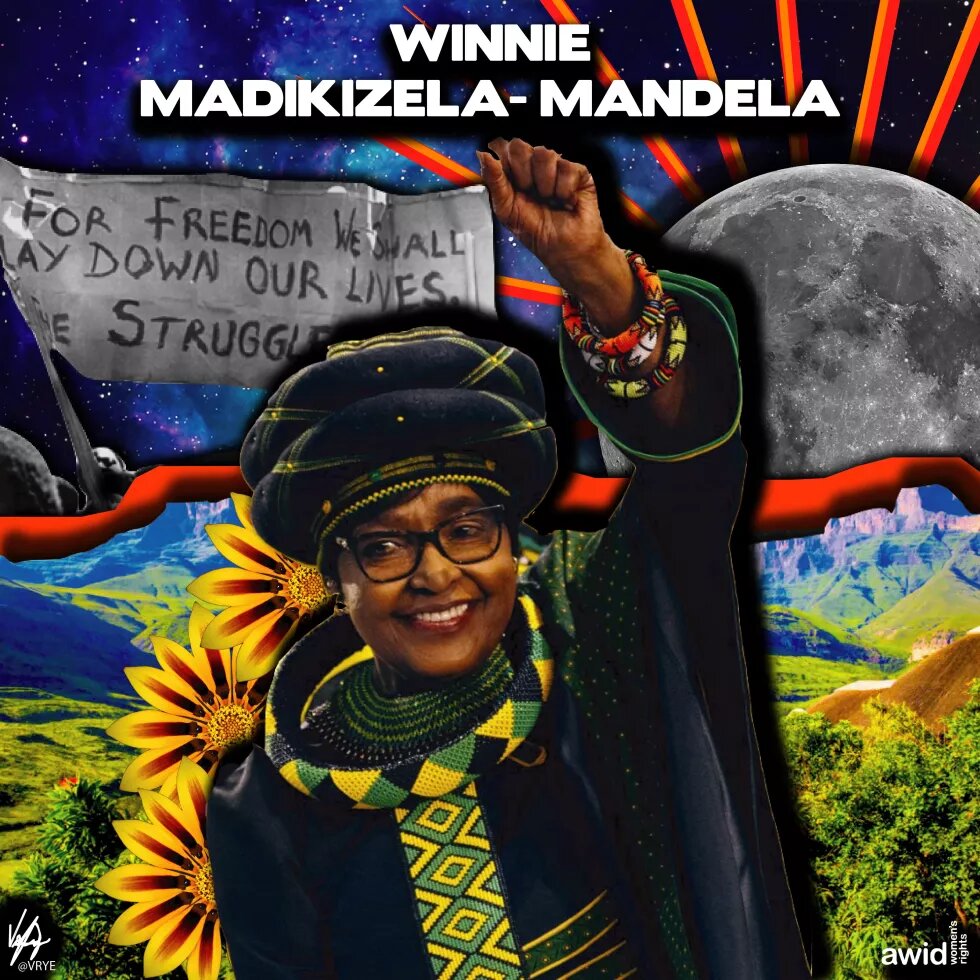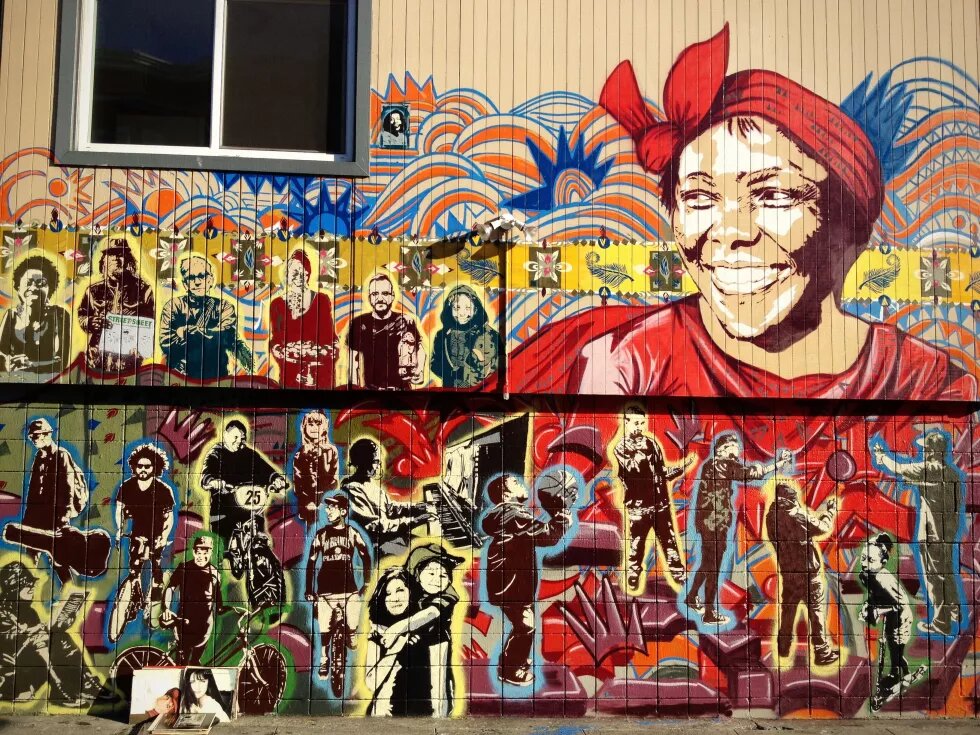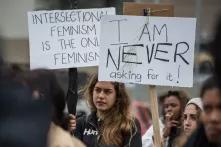
There exists, in the words of Mary Modupe Kolawole, “a commonality to the struggles women face across the world since the common factor is male privilege”1. Friedrich Engels calls patriarchy “the earliest system of domination” and2it is not natural, has not always existed, and takes different forms in all cultures and generations.3 This article brings to the fore five powerful African feminists, across time and space, who display strong resolve and courage against all odds, representing an undeterred female-led revolution with a faith that can, and has, moved mountains.

These women who lived at different times and are of different cultures and generations share a common bond. All of them met with immense resistance from, and punishment by, patriarchal systems for visibly owning their power through acts of formidable courage. In these five women, we find voices of revolution, defiance, resistance and freedom, and free minds that have defied death. These women from southern and eastern Africa, who lived between the 17th and 21st centuries, have not sat down to write feminist theory, yet their lives and actions are a living testimony to feminist voices and anti-patriarchal struggles in Africa that continue to mentor our resolve.
Kimpa Vita (Dona Beatriz) of the Kongo (1684–1706)
Kimpa Vita has been fondly referred to as Beatrice of Congo and African priestess4, Congolese prophet5, the unity prophet6, feminine Christ7, and the mother of African revolution8. Shewas born in 1684 into a family of Kongo nobility in the Kingdom of Kongo, some distance east of the capital of M’banza-Kongo in the town of Bakongo9. At the time of her birth, Kongo was torn by civil war.10 The kingdom’s disintegration was spurred by Portuguese military aggression emanating from the Angola colony to the south, notably at the battle of Mbwila in 1665, where Portuguese troops killed the Kongo ruler, Antonio.11
History tells us that Dona Kimpa Vita was later baptised Beatriz and used her Christian conviction to create a powerful political movement in the Kongo, Antonianism.12 From an early age, Kimpa Vita was considered special. She was intelligent and spiritual and given to visions. As a result, she was “trained as anganga marinda, an individual who consults the supernatural world to solve problems within the community”13. During an illness in 1704, she claimed to have received visions of St Antony of Padua, known for his powerful preaching, expert knowledge of scripture, undying love and devotion to the poor and the sick, and one of the most quickly canonised saints in church history.14 Believing herself to be the reincarnation of St Antony, she attempted to restore the ideal of Kongo as a unified Christian kingdom.15 The goal of her movement was to restore the fortunes of the once glorious kingdom of Kongo and to Africanise Christianity.
In November 1704, as the southern hemisphere’s rainy summer got underway, Kimpa Vita and her followers arrived in M’banza-Kongo, which had burnt to the ground in 1678 and whose population had been forced to flee, tearing the heart out of the country. With little food, it was hard going for the first few months. After that, the corn they had planted on arriving had ripened, and things became easier.16 Her success in re-establishing the capital won her much respect from the peasants of the kingdom, and even those she had angered recognised this “to be an incredible act and led her to be adored and acclaimed as the restorer of Kongo”17. Among her many converts were Pedro Constantinho da Silva Kibenga, the commander of one of King Pedro IV's armies sent to reoccupy M’banza-Kongo, and Hipolita, the wife of Pedro IV, who also became an Antonian convert18. Pedro IV, who had been guardedly neutral towards Kimpa Vita, now decided he would destroy her.
At the tender age of 22, Kimpa Vita was accused of heresy and burned at the stake on 2 July 1706 at the temporary capital of Evululu by forces loyal to Pedro IV.19 She was tried under Kongo law as a witch and a heretic, with the evidence, consent and counsel of the Capuchin friars Bernardo da Gallo and Lorenzo da Lucca.20 Ironically, the failure of Father Bernardo da Gallo to respect the seal of the confessional gives much of the insight we now have into Kimpa Vita’s life.
Mnyazi wa Menza (Mekatilili Wa Menza) (1860s–1925)
Mekatilili wa Menza was a Kenyan woman who led the Giriama people in a rebellion against the British Colonial Administration. She was born in the 1860s at Mutsara wa Tsatsu in Bamba, Kilifi County on the coast of Kenya. For her political activities between 1912 and 1915, she was banished to Kisii, some 800 kilometres away from her coastal village. Twice the British exiled her, and twice she returned to her people in Mijikenda (legend has it she walked back both times).21 These returns were an incomprehensible feat to the British, as the route wound through areas infested with wild animals.22 The earlier disappearance of her brother Mwarandu by Arab slavers could have been the trigger and motivation for her resistance, which is said to have been economic and socio-cultural. She wanted to withhold Giriama labour from the British in order to protect the Giriamas (the largest of the Mijikenda communities that live in Kilifi county) from enslavement in a foreign land. Mekatilili also fought against British colonisation because it was undermining and destroying the Giriama culture.23 She is considered a prophetess among the Giriama.24
Nomzamo Winifred Zanyiwe Madikizela (1936–2018)
Born on 26 September 1936 and widely known as Winnie Mandela, she was a South African anti-apartheid activist and politician, and the second wife of Nelson Mandela. After Mandela was imprisoned, she became his public face and rose to prominence both nationally and internationally in the anti-apartheid movement. She was detained by the apartheid state security forces on various occasions, tortured, subjected to banning orders, banished to a rural town, and forced to spend several months in solitary confinement.25 26
Winnie Madikizela was 22 years old and standing at a bus stop in Soweto when Mandela first saw her and charmed her.27 The couple married in 1958 and had two daughters, Zenani (born 1959) and Zindziswa (born 1960). The couples’ real married life could not have lasted the years of political turmoil, hide-and-seek, and finally the life sentence Nelson Mandela was given at the (in)famous 1963 Rivonia Trial. He was only released from prison in 1990, after 27 years. Mandela was to divorce Winnie two years after his release, citing infidelity as the cause.28. When asked in a 1994 interview about the possibility of marital reconciliation, Winnie Mandela said, “I am not fighting to be the country's First Lady. In fact, I am not the sort of person to carry beautiful flowers and be an ornament to everyone.”29
In the mid-1980s, Madikizela-Mandela had been accused of endorsing the killing of alleged police informers and apartheid government collaborators, and that her security detail had carried out kidnapping, torture, and murder30, most notoriously of 14-year-old Stompie Seipei31 whose kidnapping she was convicted of.32
Three days after Winnie's death on 2 April 2018, South African Police Commissioner George Fivaz stated, “I can say without any doubt in my mind that… there was no evidence to implicate Winnie to the Stompie Seipei murder. There was a malicious, deliberate attempt, in my opinion, to take that murder case and put it on the lap of Winnie and to say Winnie was responsible for that murder”.33 His statement came too late to exonerate or vindicate her name in her lifetime.
Wangari Maathai (1940–2011)
“That Kenya still doesn’t know what to do with thelegacy of Wangari Maathai says more about a country at war with itself than it does about the activist hero.”34 These words were written by writer and activist Nanjala Nyabola in 2015.
Yet, this is Professor Wangari Maathai. The first East African woman to earn a doctoral degree, in 1971, in veterinary anatomy.35 The first African woman to win the Nobel Peace Prize, in 2004, for her “contribution to sustainable development, democracy and peace”. An icon of Kenya’s democratic movement, who repeatedly put not just her mind but also her body on the line in order to secure a better future for Kenyans and their natural environment.36
Wangari Maathai was born on 1 April 1940 in the village of Ihithe, Nyeri District, in the central highlands of the colony of Kenya.37 In 1977, she started the ecofeminist Green Belt Movement for sustainable development and environmental conservation. Its mission is to “mobilize community consciousness for self-determination, justice, equity, reduction of poverty, and environmental conservation, using trees as the entry point”38. Speaking later of her conflict with the government, she said, “Nobody would have bothered me if all I did was to encourage women to plant trees, but I started seeing the linkages between the problems that we were dealing with and the root causes of environmental degradation. And one of those root causes was misgovernance.”39
She was denounced and insulted by the government, with President Daniel arap Moi calling her a “crazy woman”, saying that it was “un-African and unimaginable for a woman to challenge or oppose men”40. In 1979, her husband Mwangi Mathai filed for divorce, and was said to have believed that Wangari was "too strong-minded for a woman” and that he was “unable to control her”.41
Wanjiru Wanjira (1995–)
Wanjiru Wanjira was born on 3 May 1995 to Esther Wanjiru and Francis Njia.42 She has lived in Mathare – a collection of slums in Nairobi,Kenya,with a population of approximately 500,000 people43 – all her life. It was at Valley View Academy, her primary school, where she would meet an inspirational figure and her first mentor, Chaplain Barry Msumba who encouraged her and other learners that they could become whomever they wanted.
She was admitted into the University of Nairobi in 2015 but dropped out after one year due to lack of fees and stayed out of school for two years. Then Yash Pal Ghai, a renowned expert in constitutional law, and his wife Jill decided to pay her fees. Wanjiru Wanjira is now a fourth-year student in international relations and diplomacy.
With her ‘new lenses’ of education and experience, she saw the glaring injustices in Mathare. Books on Kenyan history inspired her, particularly A Prison Notebook by Maina wa Kinyatti. In 2015, she and a collective of young community activists in Mathare came together to envision a centre that would promote more participatory forms of justice. Mathare Social Justice Centre was born, with the core agenda of fighting against extrajudicial killings and political impunity. She takes pride in notable positive milestones achieved during her joint leadership at the Centre, including the transformation of the media narrative in reporting extrajudicial killings. The situation attracted the attention of Agnes Callamard, the UN Special Rapporteur on Extrajudicial, Summary or Arbitration Executions, who participated in a community-led conference in February 2020 that focused on the rampant extrajudicial killings of the poor in Nairobi.
Wanjiru Wanjira is a professed feminist who believes in the equality of the sexes. She runs the Matigari Bookclub for children in Mathare and a Mothers of Victims and Survivors Network. She is also excited that the Mathare Social Justice Forum has inspired 30 other similar forums in Kenya for people living in informal centres. She inspired Kenyans on 7 July 2020 when she resisted arrest at a demonstration in Nairobi, standing up to police officers and chanting to the crowd, “When we lose our fear, they lose their power!”
Her voice echoes Kimpa Vita’s defiance of both political and religious authorities to create a revolution in Kongo in 1704, Mekatilili’s defiance of the British colonialists in 1912, Winnie Mandela’s defiance the apartheid system in the 1970s and Wangari Maathai’s defiance of government and business conglomerates to save the environment and fight poverty.
These five women have a strong bond that joins their histories across three centuries. They faced immense resistance and were punished by patriarchal family, political or religious systems. Their beauty is not just in their resistance, but that they own their power through acts of formidable courage. Their lives portray struggles for community, national, political, economic, environmental and socio-cultural rights and freedoms. Their unrelenting focus, purpose, and actions demystify the idea that a feminist does not have to be pronounced as such: it is the cause that makes one a feminist. The domination of the female sex over centuries and across continents gave rise to feminist movements to promote women's rights and interests. Despite the patriarchal leaders and systems that have undermined their leadership and attacked their “womanhood” rather than responding to the global issues they have raised, these all-round leaders have surpassed the battle of the sexes.
- Mary Modupe Kolawole,“Transcending Incongruities: Rethinking Feminism and the Dynamics of Identity in Africa,” Agenda 17, no 54 (January 2002): 92–98, https://www.tandfonline.com/doi/abs/10.1080/10130950.2002.9676183.
- Friedrich Engels, The Origin of the Family, Private Property and the State (1884), https://www.marxists.org/archive/marx/works/download/pdf/origin_family.pdf
- Alda Facio, “What is Patriarchy?” translated by Michael Solis (2013), http://www.learnwhr.org/wp-content/uploads/D-Facio-What-is-Patriarchy.pdf.
- Dr Y., “Beatrice of Congo: the African Priestess and Prophet,” African Heritage, 16 June 2011, https://afrolegends.com/2011/06/16/beatrice-of-congo-the-african-priestess-and-prophet.
- “Kimpa Vita,” Wikipedia (4 December 2020), https://en.wikipedia.org/wiki/Kimpa_Vita.
- Carla Fernandes, “Kimpa Vita: The Unity Prophet,” 23 May 2020, video, DW Media Centre, https://www.dw.com/en/kimpa-vita-the-unity-prophet/av-53546333.
- Francisco Filipe Cruz, “Dona Beatriz Kimpa Vita, feminine Christ, Angola / Kongo, XVIII century…,” LinkedIn, 22 September 2019, https://www.linkedin.com/pulse/dona-beatriz-kimpa-vita-feminine-christ-angola-kongo-xviii-cruz.
- “Kimpa Vita, The Mother of the African Revolution,” produced by Ne Kunda Nlaba, documentary, https://www.amazon.com/Kimpa Vita-Mother-African-Revolution/dp/B07DWH2NBB.
- John K. Thornton, “Kimpa Vita: Africa’s Great Prophetess and the Anthonian Movement ofKongo,” African Heritages, 7 September 2016, https://africaheritages.wordpress.com/2016/09/07/kimpa-vita-the-great-prophetess. M’banza-Kongo is currently the capital of Angola's northwestern Zaire province with a population of 148,000.
- LLC Books, Executed Women: Kimpa Vita, Olga Taratuta, Frankie Stewart Silver (Memphis TN: LLC Books, 2010), https://www.betterworldbooks.com/product/detail/Executed-Women--Kimpa-Vita--Olga-Taratuta--Frankie-Stewart-Silver-9781158725700.
- Alexander Ives Bortolot, “Women Leaders in African History: Dona Beatriz, Kongo Prophet” in Heilbrunn Timeline of Art History (New York: The Metropolitan Museum of Art, 2000), https://www.metmuseum.org/toah/hd/pwmn_4/hd_pwmn_4.htm.
- “Antonianism, or Antonine sect, was a syncretic Bakongo Catholic movement formed in the Kingdom of Kongo between 1704 and 1708 as a development out of the Roman Catholic Church in Kongo, yet without denying the authority of the Pope.” “Antonianism,” Wikipedia (28 November 2020), https://en.wikipedia.org/w/index.php?title=Antonianism&oldid=991055806.
- Bortolot, “Women Leaders”.
- “Anthony of Padua,” Wikipedia (8 December 2020), https://en.wikipedia.org/w/index.php?title=Anthony_of_Padua&oldid=993065703.
- Cruz, “Dona Beatriz”.
- Ciaran Conliffe, “Beatriz Kimpa Vita, African Prophet,” Headstuff, last modified 9 January 2017, https://www.headstuff.org/culture/history/terrible-people-from-history/beatriz-kimpa-vita-african-prophet.
- Wikipedia, “Kimpa Vita”.
- Cruz, “Dona Beatriz”.
- Conliffe, “Beatriz Kimpa Vita”.
- Cruz, “Dona Beatriz”.
- Christine Mungai, “An Ode to the Comic, the Transgressive Counter to Stifling Official Narratives,” The Elephant, 6 August 2020, https://www.theelephant.info/culture/2020/08/06/an-ode-to-the-comic-the-transgressive-counter-to-stifling-official-narratives.
- Jason Porath, “Mekatilili wa Menza,” Rejected Princesses, https://www.rejectedprincesses.com/princesses/mekatilili-wa-menza.
- Neil Carrier and Celia Nyamweru, "Reinventing Africa's National Heroes: The Case of Mekatilili, a Kenyan Popular Heroine," African Affairs 115, no. 461 (October 2016): 599–620, https://doi.org/10.1093/afraf/adw051.
- “Mekatilili wa Menza,” Wikipedia (10 December 2020), https://en.wikipedia.org/wiki/Mekatilili_Wa_Menza.
- David Beresford and Dan van der Vat, "Winnie Madikizela-Mandela Obituary,”The Guardian, 2 April 2018, https://www.theguardian.com/world/2018/apr/02/winnie-madikizela-mandela-obituary.
- Charlene Smith, "Opinion: The Conscience of a Nation that has Forgotten Apartheid,” The Mercury, 4 April 2018, https://www.iol.co.za/mercury/opinion-the-conscience-of-a-nation-that-has-forgotten-apartheid-14240988.
- David Smith, “Nelson and Winnie Mandela's Marriage Ended, But the Bond Was Never Broken,The Guardian, 6 December 2013, https://www.theguardian.com/world/2013/dec/06/nelson-winnie-mandela-marriage.
- Robert Block, "Mandela: Winnie Made Me the Loneliest Man,” Independent, 19 March 1996, https://www.independent.co.uk/news/mandela-winnie-made-me-the-loneliest-man-1342765.html.
- Derwin Pereira, "'Invest to Rebuild S. Africa’ Call by Winnie Mandela,” Pretoria (22 June 1994), archived fromthe originalon 25 December 2014, http://derwinpereiramedia.com/singapore/derwin-pereira-invest-to-rebuild-s-africa-call-by-winnie-mandela.html.
- Paul Trewhela, “The moral problem of Winnie Mandela,”Daily Maverick, 6 April 2018, https://www.dailymaverick.co.za/opinionista/2018-04-06-the-moral-problem-of-winnie-mandela;Nastasya Tay, “Bodies Exhumed in ANC 'Murder' Case Linked to Winnie Mandela,” Independent, 12 March 2013, https://www.independent.co.uk/news/world/africa/bodies-exhumed-anc-murder-case-linked-winnie-mandela-8531758.html; Palesa Morudu, “Has truth become a casualty of Winnie's rejection of accountability?” Business Day, 13 April 2018, https://www.businesslive.co.za/bd/opinion/2018-04-13-has-truth-become-a-casualty-of-winnies-rejection-of-accountability.
- Adam Lusher, "From ‘Mother of the Nation’ to 'Mugger': The Turbulent Life of South Africa's Winnie Mandela," Independent, 2 April 2018, https://www.independent.co.uk/news/world/africa/winnie-mandela-dead-madikizela-nelson-wife-life-story-obituary-anc-football-club-soweto-apartheid-mother-nation-mugger-a8285581.html; Wet, Phillip de Wet,“Bodies Probably Won't Bury Winnie,”Mail & Guardian, 15 March 2013, https://mg.co.za/article/2013-03-15-00-bodies-probably-wont-bury-winnie; Andrew Malone,“Rough Justice for Winnie’s Victims,The Guardian, 27 April 2003, https://www.theguardian.com/world/2003/apr/27/southafrica.andrewmalone.
- Ed Cropley, "Winnie Mandela, Tarnished 'Mother' of Post-apartheid South Africa,”Reuters, 2 April 2018,https://www.reuters.com/article/us-safrica-winniemandela/winnie-mandela-tarnished-mother-of-post-apartheid-south-africa-idUSKCN1H91A6.
- George Fivaz, “No Evidence Linked Winnie to Seipei Murder: George Fivaz”, interviewed by Xoli Mngambi, eNCA, 5 April 2018, https://www.youtube.com/watch?v=P3VF468J398.
- Nanjala Nyabola, “Wangari Maathai Was Not a Good Woman. Kenya Needs More of Them,” African Arguments, 6 October 2015, https://africanarguments.org/2015/10/06/wangari-maathai-was-not-a-good-woman-kenya-needs-many-more-of-them.
- “Wangari Maathai,” Wikipedia (9 December 2020), https://en.wikipedia.org/w/index.php?title=Wangari_Maathai&oldid=993240568.
- Nyabola, “Wangari Maathai”.
- Wikipedia, “Wangari Maathai”.
- Green Belt Movement, “Who We Are,” http://www.greenbeltmovement.org/who-we-are.
- Biography.com. “Wangari Maathai,” 7 July 2020, https://www.biography.com/activist/wangari-maathai.
- Cited in Keng Fang, “Wangari Muta Maathai: Fight Against Development”, (Ecofeminism coursework, Nanyang Technological University, Singapore, 2017), https://blogs.ntu.edu.sg/hp3203-2017-14/the-environment-and-government.
- Wikipedia, “Wangari Maathai”.
- The material in this section draws from a virtual interview with Wanjiru Wanjira, conducted by the author on 22 September 2020, and several follow-ups.
- Wikipedia, “Matare” (28 March 2020), https://en.wikipedia.org/wiki/Mathare


